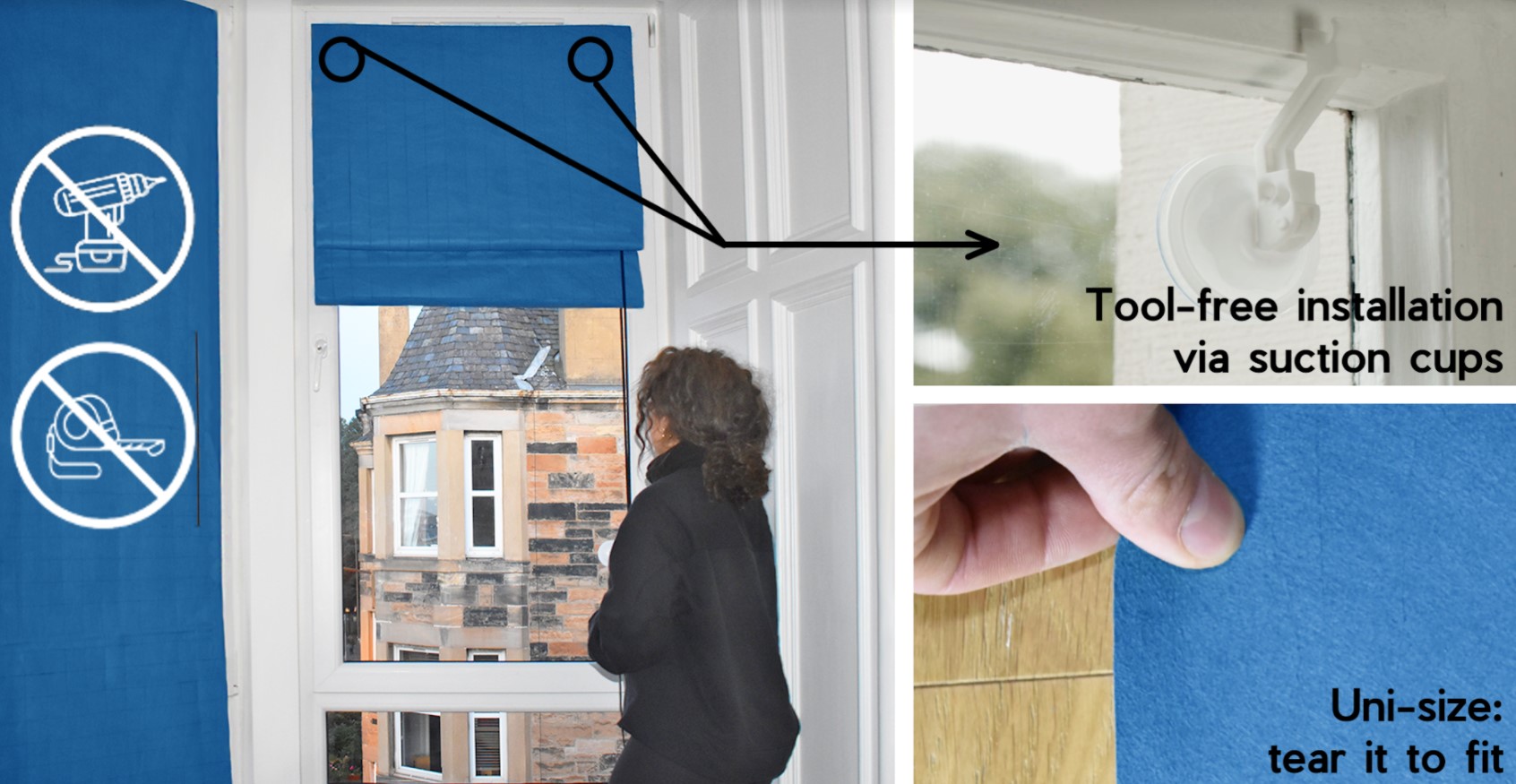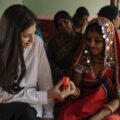As expats, the guys from Retroblind found hot and cold water taps irritating and quite literally scolding – a very British problem; thus they invented an adaptor to join separate water taps. On the back of this, they started to evaluate the other needs of their customers and problems they could solve for them – they realised that many of their clients move places frequently and temporary accommodation often does not have good window coverings, thus they invented RETROBLIND, a tool-free, tear to fit window blind – perfect for people in ‘temporary living’.
xxx
G: What problem did you set out to fix in this world?
Waste. I get pretty irritated regarding the lack of sustainability in everyday life products.
Just think about all products we consume or own, in our everyday lives. Most of these products are still made out of new, fossil-based plastics. Sometimes this is for a good reason, but in most cases, you can easily just substitute the raw materials with no loss in performance. This comes at a cost, less than 1% of the retail value, and a benefit that is surely greater than 1%.
G: How did you find your ‘Why”?
I fell in love with Scotland immediately after I moved here, but not so much the climate. In summers, the light would stay on the horizon well into the night,creeping through my curtains, waking me up. In winters, my flat would be freezing, I could literally see my breath at times. Warming the flat was expensive and energy inefficient as hot air would seep through the single glazed sash window. I felt a bit like Goldilocks, the temperatures were either a bit too hot or too cold, the sun was either too bright or too dim. I started doing my research and the least invasive course of action was simple; window blinds. However, my landlord noted that I would lose my deposit if I made alterations and therefore damaged the window frame of a listed building. I was back to square one, and then a lightbulb went off.
I am aware that window blinds are not the most attention grabbing idea, but simple inventions do change the world; the paperclip, the light bulb screw, the zipper. A tool-free, tear to fit window blind would be perfect for people who are in temporary accommodation. By eliminating the barriers, we make it possible to get a better night’s sleep, in winter or in summer. Whether it is blocking sunlight, or keeping warm in winter, it is energy efficient and economical. I enjoy improving things around me, and hate waste, it’s an intrinsic drive. And sometimes it’s possible to turn these ideas into something that is useful for other people as well. After a successful Kickstarter campaign where we met all our funding goals within 23 days. I realized that the idea was worth pursuing, that it’s just a few people that need to love (not like) what you’re doing and you might be onto something.
G: How did you converted your passion into a business?
I play with different projects and ideas all the time. Sometimes it turns out that these ideas actually have legs and you can run with them:
I started my first company; Retromixer, on a whim, five years ago. Retromixer is now operating on very little input from my co-founder and I, rewarding us with a small base income. We were pretty lucky and this salary gives us space to create new things. Part-time, I am an Entrepreneur in Residence in the Edinburgh Centre for Carbon Innovation. I support new businesses and examine various programmes; giving advice and guidance, while being challenged with new ideas, and always kept on my toes.
I believe business plans often get in the way of how early stage start-ups are meant to work. The classic business plan as we understand it is an instrument largely developed by institutions, i.e. banks and private equity investors.
When you start, you want to start with something easier, more dynamic, like a ‘business model canvas’. That’s basically a board full of sticky notes with your assumptions. Working on your idea will change most assumptions you start out with anyway.
We had a good understanding of our future customers because we were working with them for years. The product and its design changed, adapted, many times over. For Retroblind, we tested over 300 different materials, from cardboard to hemp fibers until we arrived to where we are now. The same will happen with the business model. Time will tell.
G: What were the biggest obstacles launching the company and how did you overcome them?
Focus, definitely focus. It is like going to the gym, you have to have consistency. We all are busy with a million things going on at the same time and everything seems important to us. We like to talk about it, but actually sitting down and putting in the hard work is difficult, especially when more people come into the project with their scheduling conflicts.
This is not different for me. It has been challenging to find time for a passion project and to turn it into something tangible. I found that the only way to overcome this is through self-discipline.
G: Why do you think people fell in love with your company?
We engaged existing Retromixer customers early on in the project; from concept to product development of Retroblind we had a growing audience; challenging us, nudging us in one direction or the other and tweaking the product. The idea is to get people on board early to challenge your ideas. By being open and engaging early on, while still in product development, it is easy to make it a shared project between you and your audience. They become a part of your project through things like giving feedback on your logo, which colours do people like, where would they use your product. This engagement is fun, valuable, and it is no longer just your project, it is also their project. We were surprised by the answers that we got.
G: How do you promote your brand?
We have found a behavioral economics approach as quite effective. Emotions take a part in shaping our consumer habits and studies point out that consumer decision making is 30 percent rational and 70 percent emotional. Surprisingly we have found that by appealing our product as an end to our customers frustrations as opposed to a benefit to the environment has gotten it more attention. Moreover, clever advertising campaigns about blocking out 2020 by simply pulling the blinds down on; the election in America, Covid-19, everything 2020, has been effective in piquing curiosities which have converted into attention.
G: What 3 pieces of advice would you give to the people who want to create something, but not sure how or where to start ?
1 – Write down your ideas, I mean any idea that you have. ANY! Go for quantity over quality. The process of writing down many ideas triggers a small accomplishment when you do it. And it’s good to split between idea creation (crazy & silly) and the objective assessment of them. This can happen weeks later.
2 – Talk to your friends. Take them out for long walks and just talk. Often there are hidden talents, quirky hobbies, or missed opportunities, maybe they have business ideas of their own and there is a possible collaboration to be made.
3 – Talk to your friends!!! To go on these walks and talk openly, it requires trust. People are weirdly protective of their ideas and often do not like sharing them. This goes both ways. Don’t hold back. It is unlikely that the person you’re talking to is going to steal your idea.
G: Have you had any mentors or role models that have influenced you?
Actually, I just had a long and painful conversation, which lasted over four hours last night with a good friend and mentor of mine. It is helpful to have a neutral person on the table that can navigate through emotionally driven decisions and ask the hard questions.
You must surround yourself with people that can challenge and advise you. We have been talking about different drivers underlying our marketing strategy and their implication: Do you want to build your business based on a strong community? How do you scale from there? How does this align with your future sales channels?
It’s good to have difficult conversations early on.
Per influences, I would note the founder of Samsung; Byung-Chull Lee. He founded the company as a trucking/exporter, shipping items like dried fish and flour to China. He would constantly adapt to the changing environment; with the start of the Korean War and later the geopolitical tensions in Asia, he was always making pivots. Focusing later on insurance, securities, and retail. Following that into electronics, televisions at first, and now once dried fish exporter is responsible for nearly 20% of all mobile devices sold in the world. He created a company that was always adapting through small and large pivots and that is nothing short of inspirational.
G: Who/what are your favorite CEOs/Businesses in Shoreditch or East London?
I am a big fan of TransferWise. I still remember how impressed I was when I initially heard about them. It must have been in 2014/15. I was still living in Germany, but started spending more and more time in the UK. The simplicity of their business model was eye-opening. It was right in front of you, anyone, but somehow they saw it. They have currency accounts in each country they operate in. They exchange the money of their customers, while not actually moving the money cross-border for each transaction, only the surplus.
Within weeks I convinced a couple of friends and got their £50 referral bonus if I remember the amount correctly. They built a great team of investors with payment experience around them.
G: Where do you see your company in a few years’ time and what are your thoughts on the future of your industry and how is it changing?
I’d like to establish us as a small launchpad, a creative team with great people that actually like their jobs. Working in a fast paced environment, and can move the needle. I spent some time working for a blue-chip company, learned a lot, but I found the nine to five was soul crushing.
Reports show a third of consumers prefer sustainable brands, and we expect this number to grow. Ikea, Unilever amongst other companies are ramping up their sustainability platforms, outreach and products. What we looked to do is fill the gap, that grey area, where we make small innovations, niche products for specific customer segments and focus on reduction of consumerism, waste as opposed to driving sales by economies of scale.





